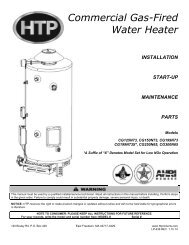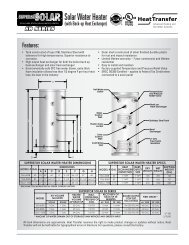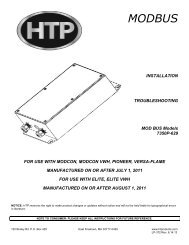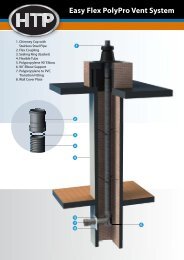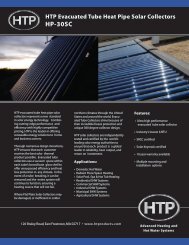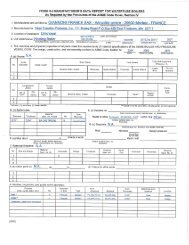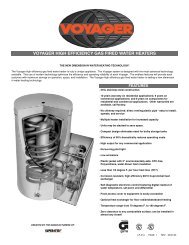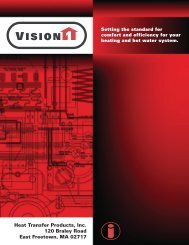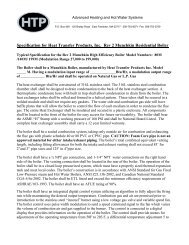MC Series Gas-Fired Circulating Heater - Heat Transfer Products, Inc
MC Series Gas-Fired Circulating Heater - Heat Transfer Products, Inc
MC Series Gas-Fired Circulating Heater - Heat Transfer Products, Inc
Create successful ePaper yourself
Turn your PDF publications into a flip-book with our unique Google optimized e-Paper software.
The building frame (studs) must be 16" on center. If not, you must use 1/2" minimum plywood 24" x 48", fastened with at least (14) #12<br />
x 3" (3/16" x 3") round head tapping screws to the frame of the building to provide proper support for the heater. Alternate methods of<br />
mounting must not be used. (ex. toggle bolts, hollow wall anchors) or any other fastener other than #12 x 3" (3/16" x 3") round head<br />
tapping screws.<br />
15<br />
If the heater is not vertically plumb, improper and unsatisfactory operation may occur, causing excessive condensation build-up,<br />
nuisance fault codes, and unnecessary maintenance.<br />
D. INSTALLATION STEPS<br />
1. Prior to lifting the heater onto the wall, use the enclosed template to level and locate the 2 primary (#12 x 3" [3/16" x 3"]) round head<br />
tapping screws, leaving about 1/4" between the screw head and the wall surface to allow for access to the keyway slot located in the<br />
back of the heater panel. It is extremely important that the line on the template is level when locating the first 2 screws. Failure to do so<br />
will result in an uneven or out of level installation.<br />
2. Remove the heater cover. Locate the 2 keyway slots over the screws. Then lower the heater onto the smallest part of the keyway<br />
slot.<br />
3. Once the heater is mounted on the first 2 screws, finish tightening the screws to the back panel. Then install the 6 additional screws<br />
of the same size to the back panel holes. This will provide additional strength and support to the heater.<br />
PART 5 – HEATER PIPING<br />
Failure to follow the instructions in this section WILL VOID the warranty and may result in property damage, serious injury, or death.<br />
Never use dielectric unions or galvanized steel fittings when connecting to a stainless steel storage tank or heater. Use only copper or<br />
brass fittings. Teflon thread sealant must be used on all connections. All piping and components connected to the heater must be<br />
approved for potable water systems.<br />
Plumbing of this product should only be done by a qualified, licensed plumber in accordance with all local plumbing codes. The heater<br />
may be connected to a storage tank to supply domestic hot water. HTP offers 60/80/119/175 gallon size storage tanks in either<br />
stainless steel or glass-lined construction. These storage tanks can be directly connected to the heater supply and return connection.<br />
The National Standard Plumbing Code, the National Plumbing Code of Canada, and the Uniform Plumbing Code limit the pressure of<br />
the heat transfer fluid to less than the minimum working pressure of the potable water system up to 30 psi maximum. The heat transfer<br />
fluid must be water or other non-toxic fluid having a toxicity of Class 1, as listed in Clinical Toxicology of Commercial <strong>Products</strong>, 5 th<br />
Edition.<br />
A. GENERAL PIPING INFORMATION<br />
The building piping system must meet or exceed the piping requirements in this manual.<br />
Use two wrenches when tightening water piping at heater. Use one wrench to prevent the heater return or supply line from turning.<br />
Failure to prevent piping connections from turning could cause damage to heater components.<br />
1. The water supply should be shut off while connecting the heater. A manual control valve must be placed on the inlet connection to<br />
the heater. Unions can be used on both the hot and cold water lines for future servicing and disconnection of the unit.<br />
2. Purge the water line to remove all debris and air. Debris will damage the water heater.<br />
3. If the heater is to be used as a potable water source, it must not be connected to a system that was previously used for non-potable<br />
purposes.<br />
4. Ensure that the water filter on the heater is clean and installed.<br />
LP-171 Rev. 10.2.13



